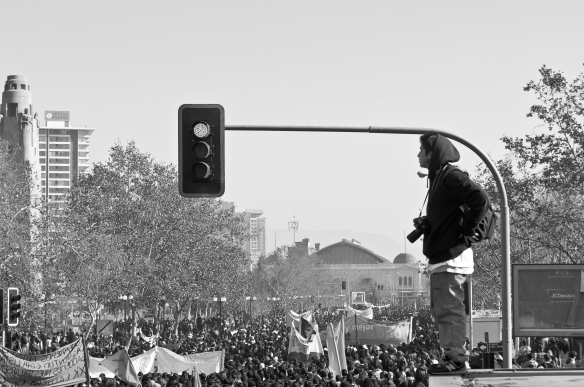 Unknown photographer @creativecommons
Unknown photographer @creativecommons
July 2011 by Sara Carrasco Granger
What started five months ago as a few scattered university meetings quickly became a country-wide movement that is not only fighting for the right to education, but is fighting for a more democratic society. How did the struggle for the right to education come to encompass demands of major structural changes, receiving close to an 80% approval rate?
Back in May the mobilization was mostly confined to university students. In June, it included high school and elementary students that were joining in the tomas, the physical occupation of schools and universities. By the end of the month, a massive public choreography of Michael Jackson’s Thriller symbolizing the death of education took place in front of La Moneda with a strikingly impressive coordination that sent a crucial message: the movement is big, unified, and above all, pacifist in nature.
August began with a violently crushed protest by police, and ended with a two-day national strike organized by a major worker’s union, where 300,000 people marched through the capital’s streets demanding “a new constitution, labor law code, and the dismantling of the economic model that has remained unchanged since the dictatorship”.
Ever since the U.S. backed coup on September 11th of 1973, along with completing an outstanding record on human rights violations, the military dictatorship began its radical agenda of neoliberal policies. Guided by Milton Friedman and his loyal followers, the Chicago Boys, it shrank taxes and social aid, for which the country now enjoys high growth rates and outstanding inequality levels.
The unraveling of the movement has shed light on Pinochet’s legacy: an economic model that reproduces old, and breeds new, inequalities; the continued oppression of rights of women, homosexuals, and the Mapuche; police brutality through tear-gas, high-pressure water hoses, rubber, and most recently, real bullets, used to enforce the elite’s ideal of traditional ‘family values’.
Whose family? I guess that remaining 20% …
The confrontations are getting out of hand. The two-day protest resulted in 1,394 arrests, 153 policemen, and 53 civilians injured, and a 16-year-old boy that died from a policeman’s bullet, with the police being able to hold back an internal investigation for several days. The leader of the student movement, Camila Vallejo, has been called a “piece of shit” by the vice president of the conservative political party, Renovación Nacional, and is confronting bluntly sexist, and fascist remarks, such as “matando a la perra, se acaba la leva”, a centuries-old saying that comes from the custom of killing off female dogs so that the male dogs, the ‘stronger ones’, will cease to be distracted by following the females around. A phrase that in Chile is remembered as having been uttered by Pinochet, as he referred to Allende’s death, the democratically elected socialist politician that the military removed from power.
The recent violence employed by the state against protestors struggling for their rights has led to a tapping into the collective memory of oppression and injustice of Chileans, who are redefining the values they want their state to defend.
